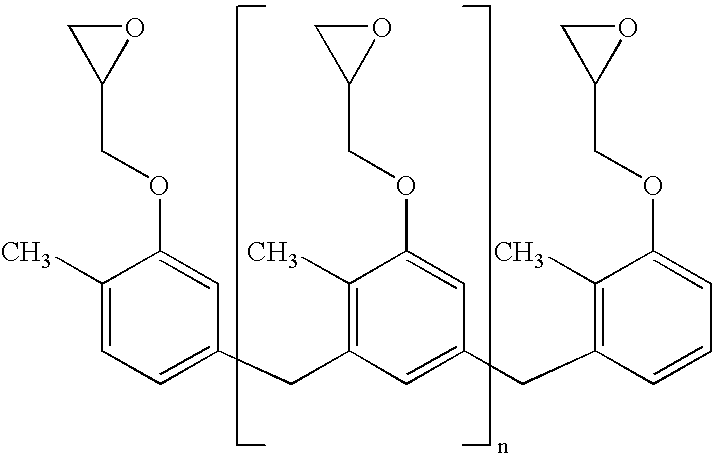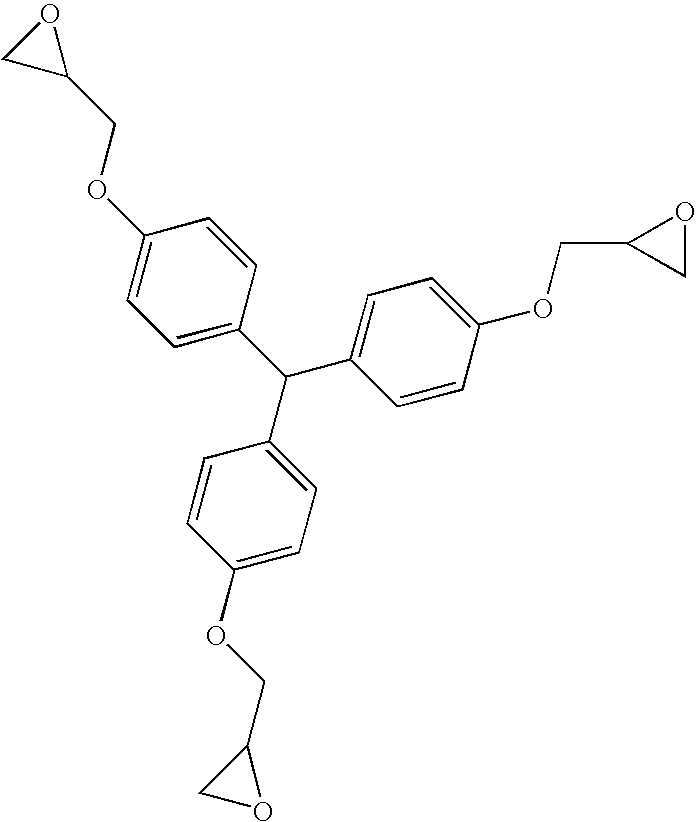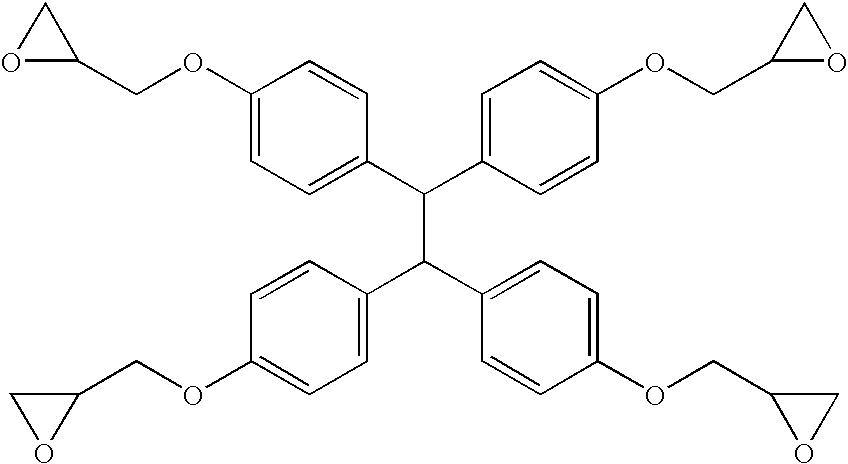Molding compositions containing quaternary organophosphonium salts
a technology of quaternary organophosphonium salts and compositions, applied in the direction of synthetic resin layered products, transportation and packaging, chemistry apparatuses and processes, etc., can solve the problems of bromine-containing flame retardants (especially brominated diphenyl ethers), further environmental concerns, and polluting the environment. , to achieve the effect of good physical integrity
- Summary
- Abstract
- Description
- Claims
- Application Information
AI Technical Summary
Benefits of technology
Problems solved by technology
Method used
Image
Examples
example 1
[0061] Five molding compositions represented as Sample Nos. 1-5 were prepared according to the formulations as indicated in Table 1 below. Each molding composition contained an epoxy cresol novolac resin with a standard phenol novolac hardener. With the exception of Comparative Sample 1, each composition contained a phosphonium functional acetic acid ester compound as a catalyst. The weight % (wt %) indicated below were calculated based on the total weight of the compositions.
TABLE 1SAMPLE NO.1COMPONENTS(comparative)2345Silica Filler (wt %)82.4582.2382.3382.4382.53Epoxy Cresol Novolac Resin (wt %)5.685.685.685.685.68Phenol Novolac Hardener (wt %)0.360.180.180.180.18Flexible Type Hardener3.253.253.253.253.25(Bisphenol-M) (wt %)Flexible Type Hardener1.481.781.781.781.78(xylock novolac type) (wt %)TPP Catalyst (wt %)0.02————DBU Catalyst (wt %)0.13————EtTPPOAc Catalyst (wt %)—0.250.250.250.25Melamine Cyanurate Flame Retardant1.701.701.601.501.40(Melapur MC-25 from DSM Corp.)(wt %)Poly...
example 2
[0064] Six molding compositions represented as Sample Nos. 6-11 were prepared according to the formulations as indicated in Table 3 below. Each molding composition contained a standard epoxy cresol novolac resin and a flexible novolac hardener, along with two known flame retardants at varying amounts. Comparative Sample Nos. 6-8 included conventional catalysts, while Sample Nos. 9-11 contained a phosphonium functional acetic acid ester compound as a catalyst. The weight % (wt %) indicated below were calculated based on the total weight of the compositions.
TABLE 3SAMPLE NO.678COMPONENTS(comparative)(comparative)(comparative)91011Silica Filler (wt %)80.9880.9880.9880.8680.8680.86Epoxy Cresol Novolac Resin (wt %)6.166.276.496.166.276.49Phenol Novolac Hardener (wt %)0.180.180.180.180.180.18Flexible Type Hardener5.475.565.745.475.565.74(xylock novolac type) (wt %)TPP Catalyst (wt %)0.020.020.02———DBU Catalyst (wt %)0.110.110.11———EtTPPOAc Catalyst (wt %)———0.250.250.25Melamine Cyanurat...
example 3
[0067] Six molding compositions represented as Sample Nos. 12-17 were prepared according to the formulations as indicated in Table 5 below. Each molding composition contained a standard epoxy, cresol novolac resin and a flexible novolac hardener, along with melamine cyanurate as a flame retardant at varying amounts. Comparative Sample Nos. 12-14 included conventional catalysts, while Sample Nos. 15-17 contained a phosphonium functional acetic acid ester compound as a catalyst. The weight % (wt %) indicated below were calculated based on the total weight of the compositions.
TABLE 5SAMPLE NO.121314COMPONENTScomparativecomparativecomparative151617Silica Filler (wt %)83.6883.6883.6883.5783.5783.57Epoxy Cresol Novolac Resin (wt %)5.535.645.755.535.645.75Phenol Novolac Hardener (wt %)0.180.180.180.180.180.18Flexible Type Hardener4.844.935.024.844.935.02(xylock novolac type) (wt %)TPP Catalyst (wt %)0.020.020.02———DBU Catalyst (wt %)0.120.120.12———EtTPPOAc Catalyst (wt %)———0.250.250.25M...
PUM
| Property | Measurement | Unit |
|---|---|---|
| Fraction | aaaaa | aaaaa |
| Fraction | aaaaa | aaaaa |
| Fraction | aaaaa | aaaaa |
Abstract
Description
Claims
Application Information
 Login to View More
Login to View More - R&D
- Intellectual Property
- Life Sciences
- Materials
- Tech Scout
- Unparalleled Data Quality
- Higher Quality Content
- 60% Fewer Hallucinations
Browse by: Latest US Patents, China's latest patents, Technical Efficacy Thesaurus, Application Domain, Technology Topic, Popular Technical Reports.
© 2025 PatSnap. All rights reserved.Legal|Privacy policy|Modern Slavery Act Transparency Statement|Sitemap|About US| Contact US: help@patsnap.com



